
The Urinating Figure in European Art
The History of the Urinating Figure in Art
Jean-Claude Lebensztejn, a French art critic, has written Pissing Figures, 1280-2014, a history of what he calls our "diuretic fantasies" embedded in western artwork — the pisseur and pisseuse and, most commonly in the earliest examples, the young boy.
Images of urinating young boys, what art historians call the putto or puer mingen, first appeared in the margins of illuminated manuscripts in the 1200s. Before you become too offended, remember that European books and artwork in that period were almost entirely created for and used within the church. It was holy pee, you see. The putto were young angels, with wings, laurel wreaths, and streams of urine. In the first few centuries of European peeing art within Christian settings the putto appeared at parties and feasts. These were, ironically, depictions of Roman bacchanalia or Greek Διόνυσια co-opted as Christian church decoration. Life as an endless party, endlessly sprinkled by the cherubim.
Amazon
ASIN: 194170154X
And before you become too offended by the non-clinical language, remember that "piss" was the terminology of the King James' "Authorized" English translation of the Bible.
Therefore, behold, I will bring evil upon the house of Jeroboam, and will cut off from Jeroboam him that pisseth against the wall, and him that is shut up and left in Israel, and will take away the remnant of the house of Jeroboam, as a man taketh away dung, till it be all gone.
— 1 Kings 14:10 (KJV)
Behold, I will bring evil upon thee, and will take away thy posterity, and will cut off from Ahab him that pisseth against the wall, and him that is shut up and left in Israel, And will make thine house like the house of Jeroboam the son of Nebat, and like the house of Baasha the son of Ahijah, for the provocation wherewith thou hast provoked me to anger, and made Israel to sin.
— 1 Kings 21:21-22 (KJV)
For the whole house of Ahab shall perish: and I will cut off from Ahab him that pisseth against the wall, and him that is shut up and left in Israel: And I will make the house of Ahab like the house of Jeroboam the son of Nebat, and like the house of Baasha the son of Ahijah: And the dogs shall eat Jezebel in the portion of Jezreel, and there shall be none to bury her. And he opened the door, and fled.
— 2 Kings 9:8-10 (KJV)
Lebensztejn describes the Ovetari Chapel in Padua, where Andrea Mantegna's cycle of frescoes included a pissing putto suspended from a garland, where he "lets loose a long jet of urine, as if it were a bemused symbolic paraphrase of the baptismal water."
Their numbers increased while artwork spread. By the 1400s Lebensztejn described the artistic scene as one in which "processions of urinating children set about inundating paintings and sculptures in villas and public squares."
By the 1600s art was appearing outside church settings. The first picture below is an etching from the Netherlands, dated to 1610-1685. It's in the collection of the Metropolitan Museum of Art in New York City, where it's accession number 51.501.1351, a gift of the Elisha Whittelsey Fund, and it's known as The Pissing Man. Most artworks don't have a specific title assigned by the artist. For example, English speakers will insist that a famous Leonardo da Vinci painting in the Louvre is The Mona Lisa, while the people in France where that painting is located know it as La Joconde, based on its Italian name La Gioconda. The titles come from a description by a historian during the Renaissance. Leonardo simply painted it and said "Here is this portrait." So, titles can be bland.
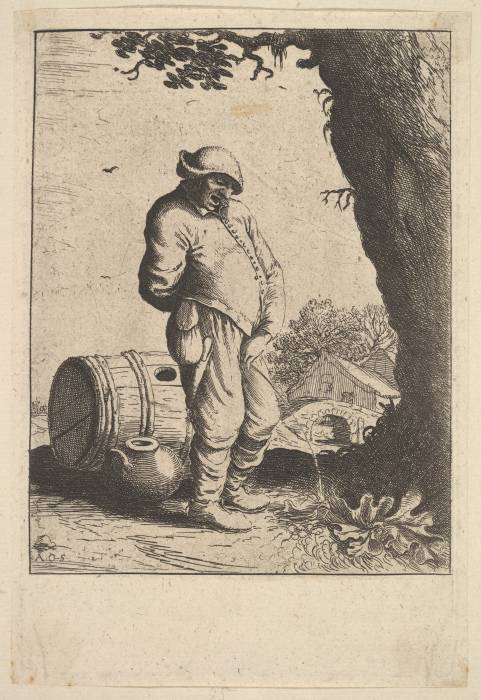
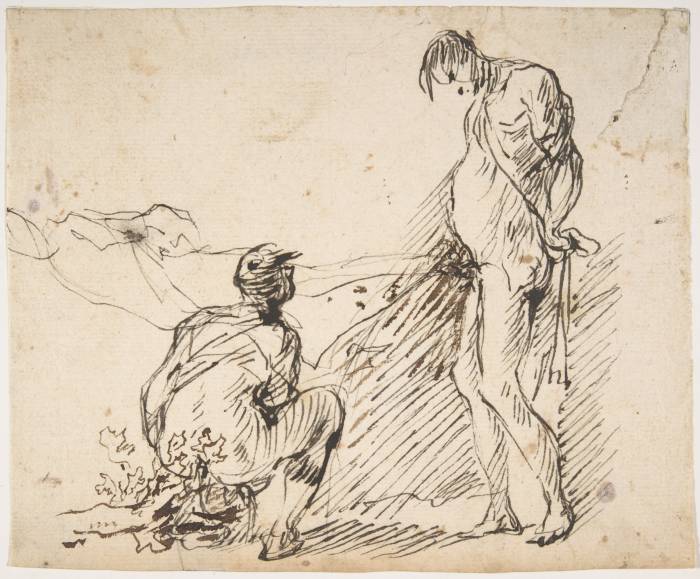
The second image above is known as A Crouching Man Defecating and a Standing Man Urinating, accession number 17.236.32 in the Metropolitan Museum of Art collection. See what I mean about plainly descriptive titles?
It's in pen and brown ink, 15.2×18.4 cm, done in Italy some time in 1612-1675. It has been owned by European nobility including Don Sebastián Gabriel de Borbón y Braganza (1811-1875) and Don Pedro Alcántara de Borbón y Borbón, the Duke of Dúrcal (1862-1892). It entered the museum collection in New York in 1889.
Below are two etchings by Rembrandt van Rijn, Pissing Man and Pissing Woman, both from 1631. Or in Dutch, Plassende Man and Plassende Boerenvrouw as she's a farmer's wife. These two etchings are in the Teylers Museum in Haarlem.
Art historians think that Rembrandt made these etchings in response to Jacques Callot's carving Capricci di varie Figure, in which a man is crouching and urinating in a pose very similar to Rembrandt's farmer's wife.
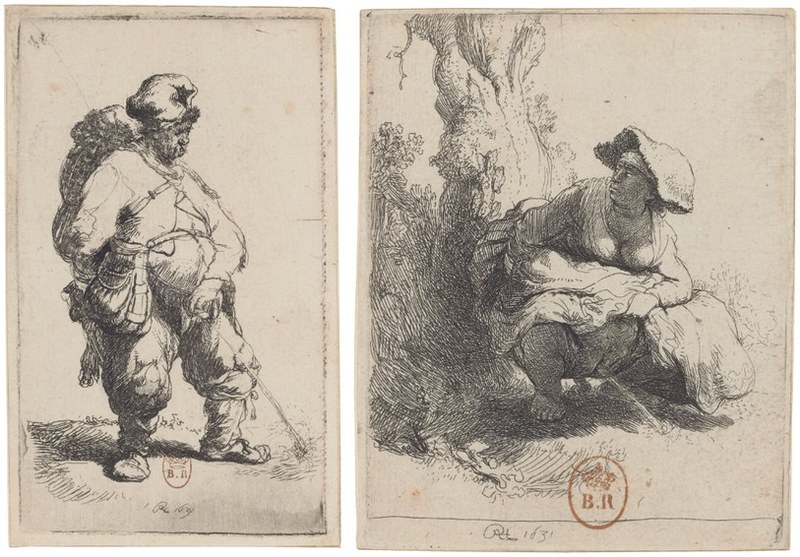
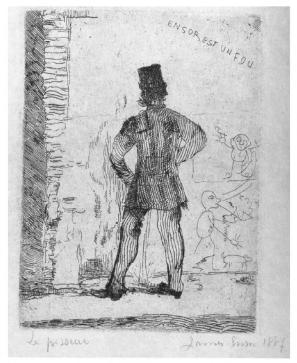
James Ensor, Man Pissing, Ensor et un Fou, etching, 1887.
According to Lebensztejn's analysis, the depictions of common people urinating from the 1600s through the 1800s had a certain innocence. He describes the Tahitian woman squatting in Paul Gauguin's Te Poipoi of 1892 as the last truly innocent pissing figure in western art. He says that she offers "a modern-primitive vision of the Golden Age" when public toilets were finally returning to European civilization and acts of urination and defecation were becoming much more private.
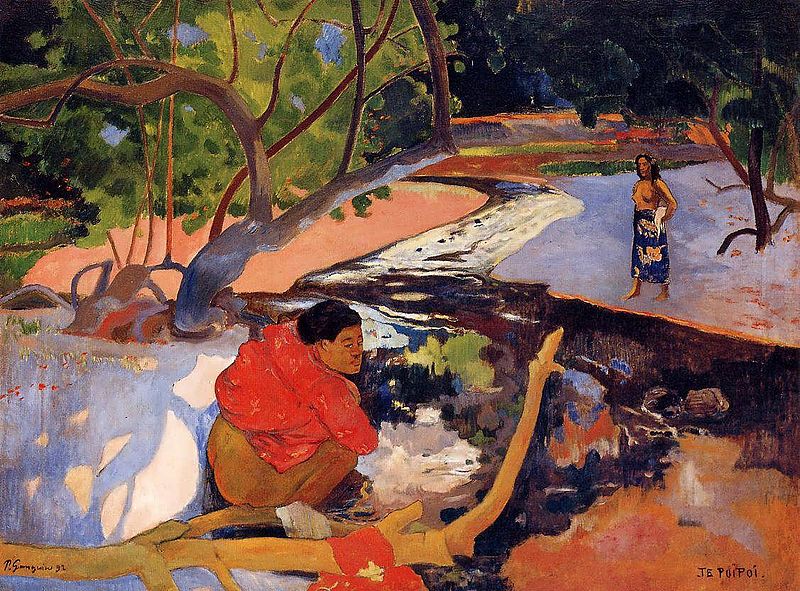
Paul Gauguin, Te Poipoi, 1892, 68×92 cm. It sold for US$ 39,241,000 in an auction in 2007.
Once public toilets appeared and the act of urination was supposed to be kept private, its depiction became erotic. Pablo Picasso, Paul Klee, Jean Dubuffet, Charles Demuth and others painted eroticized pisseuses and pisseurs.
Urine-centric art escalated from there into what Lebensztejn calls "a barrage of urinary provocations, each one more provocative than the last."
Urophagia
is the practice of drinking urine,
your own or that of others.
Urolagnia,
also called urophilia,
is a paraphilia in which sexual excitement is associated
with urine.
See, for example,
Donald Trump and the Pee Tape.
Photographers began capturing the pisseuses and pisseurs, some of them caught in the act of urophagia.
Jackson Pollock is famous for his paint-spattered canvases. He is also said to have sprayed a canvas with his own urine before delivery whenever he didn't like the dealer or client.
Andy Warhol coated canvases with metallic paints, and used his and his assistants' urine to generate artworks based on chemical reactions.
In 1987 Andres Serrano exhibited Immersion (Piss Christ), a 100×150 cm photograph of a small plastic crucifix submerged in the artist's urine. The artist said that it was intended as a denunciation not of religion, but of the commercializing and cheapening of Christian icons in contemporary culture. And I'm reminded here of Christmas decorations put up in early October, and the constant rotation of Christmas-themed music and movies for two to three months every year.
Fluxus and Toilets as Modern and Contemporary ArtWhen the photograph was exhibited again in 1989, conservative U.S. politicians noticed it and reacted predictably. The artist received death threats. Then the galleries that had exhibited it received death threats. Because, for some people, death threats are what Christianity is all about.
Meanwhile the Basilica of Saint Francis of Assisi still displays its 13th-century fresco where three angels, grown men with laurels, halos, wings, and full bladders, hold their penises above Christ on the cross, ready to relieve his suffering with a rain of urine.
Lebensztejn hopes that we might regain some urine-based prelapsarian utopia as a society that finds new uses for its liquid waste. He cites a passage from Pliny's Natural History, wondering whether we will witness "centenarians restored to youth by the regular ingestion of their own urine, food sources purified by its deployment as fertilizer, and machines powered by reprocessed piss."

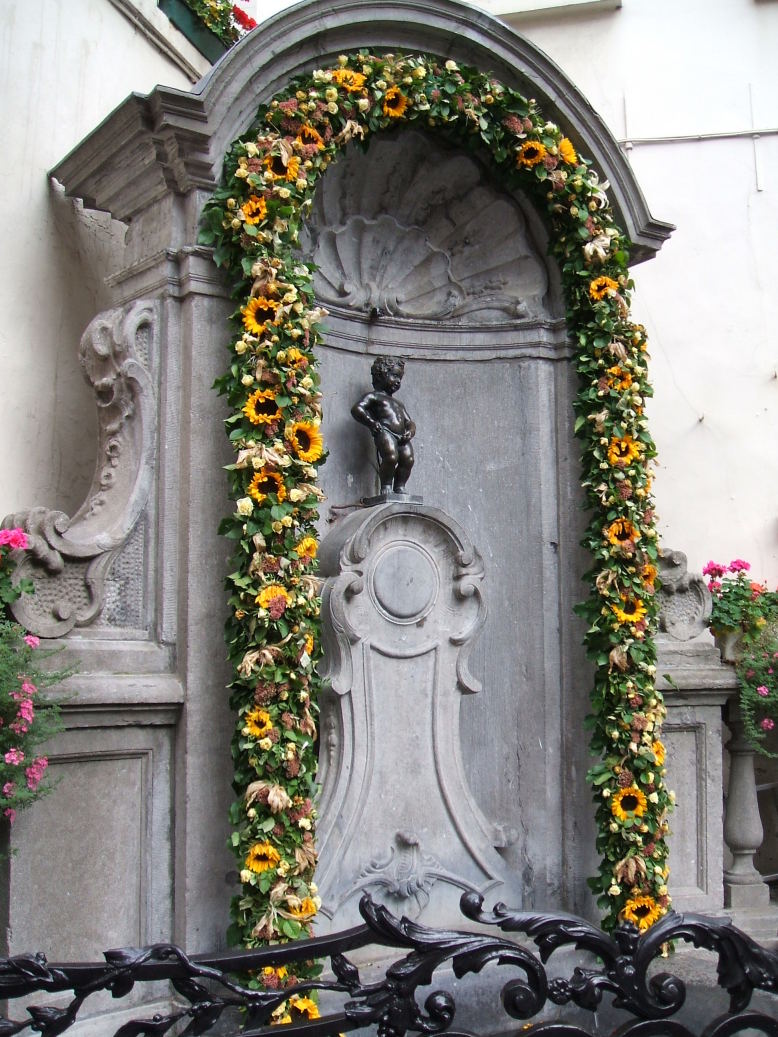
Peeing Statues in Brussels:
Manneken Pis, Jeanneke Pis, & Zennike Pis
Brussels is a good place to find urine-focused art. One of the main tourist attractions in Brussels is a small statue of a urinating boy. It's a classic example of the Peeing Putto. Similar statues of a girl and a dog have been added in the past few decades.
Manneken Pis
Manneken Pis stands just two feet or 61 cm tall, but crowds of people jostle to get a close look and take a picture. The statue has been drawing people to this part of the Belgian capital since the early 1600s.
The current bronze statue was made by Hieronimus Duquesnoy the Elder in 1619. It replaces an earlier one dating from 1388.
The name Manneken Pis means "Little Man Pee" in Marols, a dialect of Dutch spoken in Brussels back when the Hapsburgs ruled the Low Countries in the 16th and 17th centuries. It incorporated many French words and a few Spanish words, and has survived to today as a mixture of Dutch and French that is simultaneously neither and both at once.
To get there, he's at the intersection of Rue de l'Étuve / Stoofstraat and Rue du Chêne / Eikstraat — every street in Brussels has both Walloons (Belgian French) and Flemish (Belgian Dutch) names. Take the street to the left of the Brussels Town Hall — not the street in the far south corner of Grand-Place but the next street to its right. Walk three short blocks, you will see the crowd before you get there.
The most famous legend behind this statue has to do with Duke Godfrey III of Leuven. He grew up to be count of Leuven, landgrave of Brabant, margrave of Antwerp, and the duke of Lower Lorraine. But while he was still an infant, he succeeded Godfrey II.
Since things were being run by grownups on behalf of the child, the Wars of Grimbergen broke out in 1141-1159 as some small regions of Flemish Brabant attempted to become independent of the dukes of Lower Lorraine.
The story is that the infant duke's troops (who seem to have brought a baby to a battle) put Godfrey in a basket and hung the basket in a tree, so as to encourage his troops. From there, he urinated on the opposing troops who eventually lost the battle.
Belgian surrealist René Magritte and Trompe l'Oeil ToiletsThere are other legends, of course. One says that Brussels was under siege and the attackers had placed explosive chages along the city walls. A young boy just happened to see this, urinated on the burning fuse, and saved the city.
Or, a young boy was awakened by a fire, put it out by urinating on it, and saved the king's castle from burning down.
Or, some variation on a young boy who went missing in the city and was found urinating in a garden.
Here is Manneken Pis in all his diminutive glory. Really. That's all there is.
It's just one little statue, and it's small.
But the little square he overlooks gets very crowded. everyone is determined to see him.
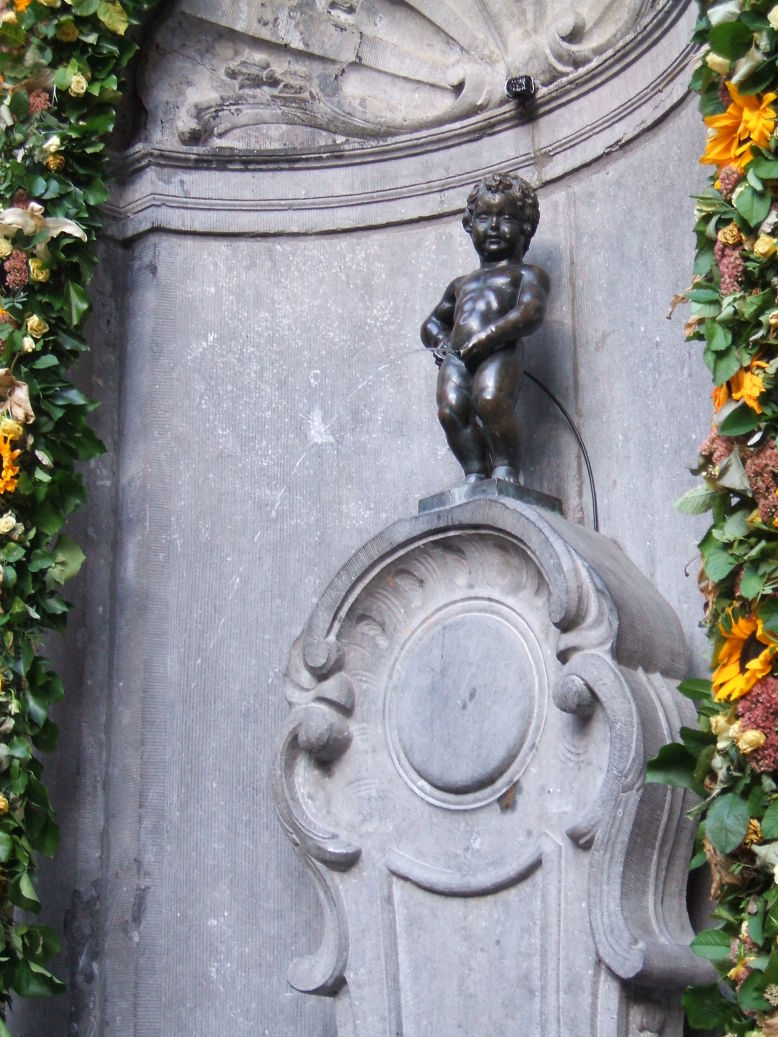
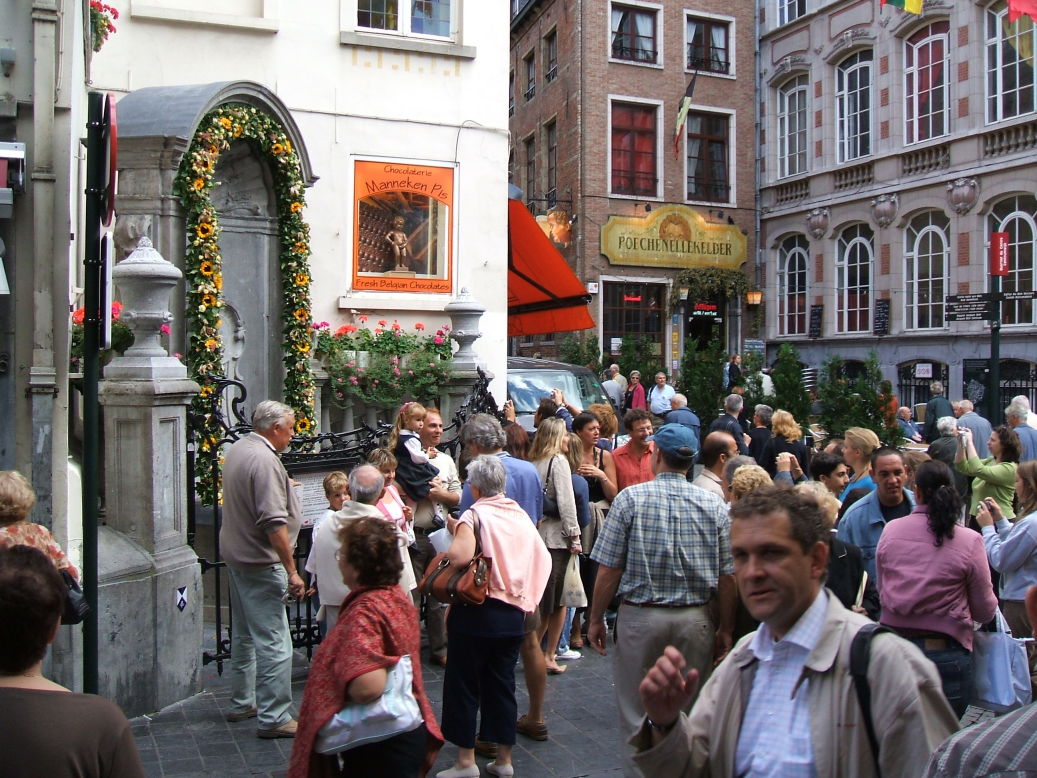
As you can see, he's quite the tourist attraction.
They dress him in costumes several times a week, with a schedule posted on the railings.
The tradition of putting costumes on the statue go back to soon after the statue's installation. But it was in the 20th century that the number of costumes grew into the hundreds. They commemorate various trades and professions and branches of the Belgian military and civil services. Plus, more recently, national costumes of foreign visitors to Belgium.
Jeanneke Pis
Figuring that if one such statue was a good thing, then two would be twice as good, a local artist created Jeanneke Pis. She is also plumbed for realistic operation.
To get there, she's on the right-hand side near the end of the 30-meter-long dead-end alley Impasse de la Fidélité / Getrouwheidsgang. That alley leads north off the narrow passageway packed with restaurants and obstructed by restaurant touts, and known as Rue des Bouchers / Beenhouwersstraat.
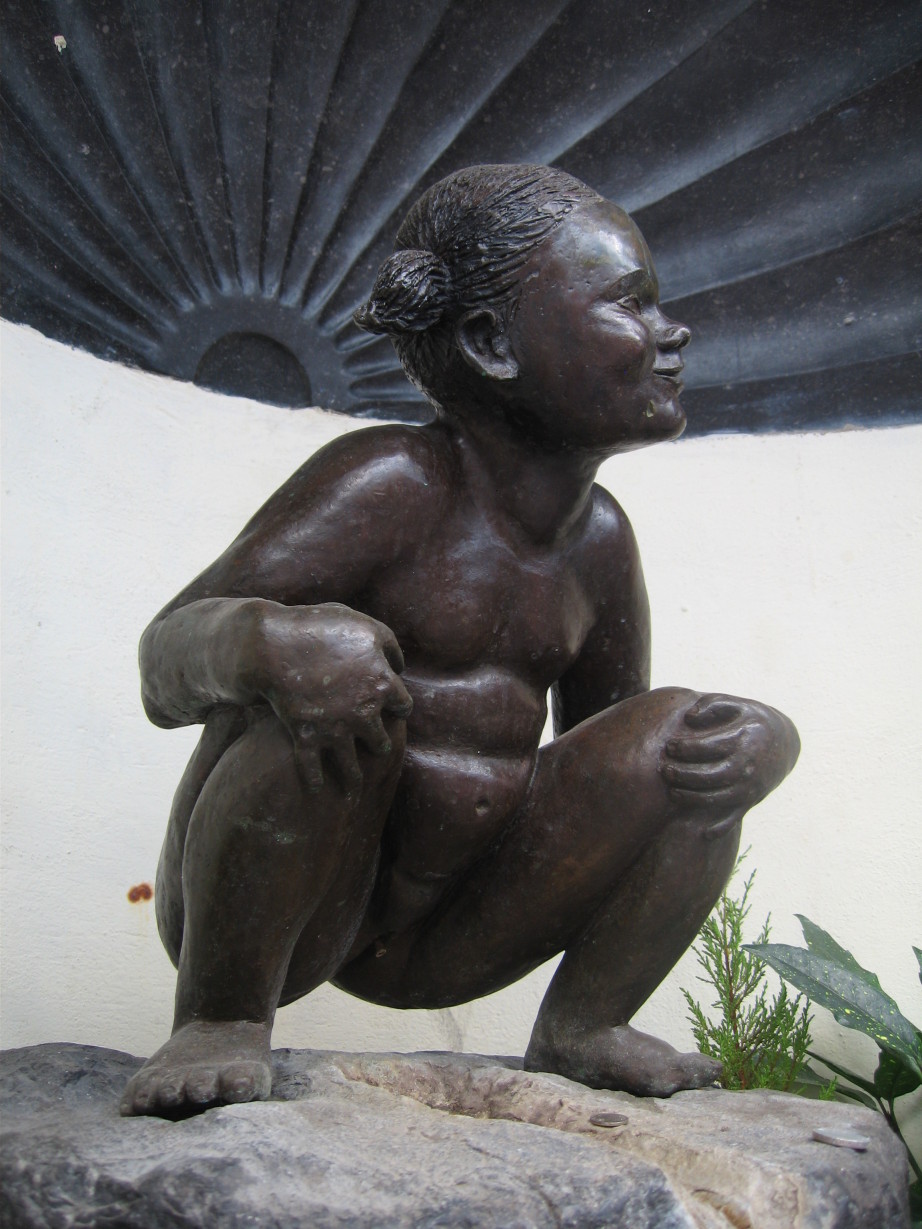
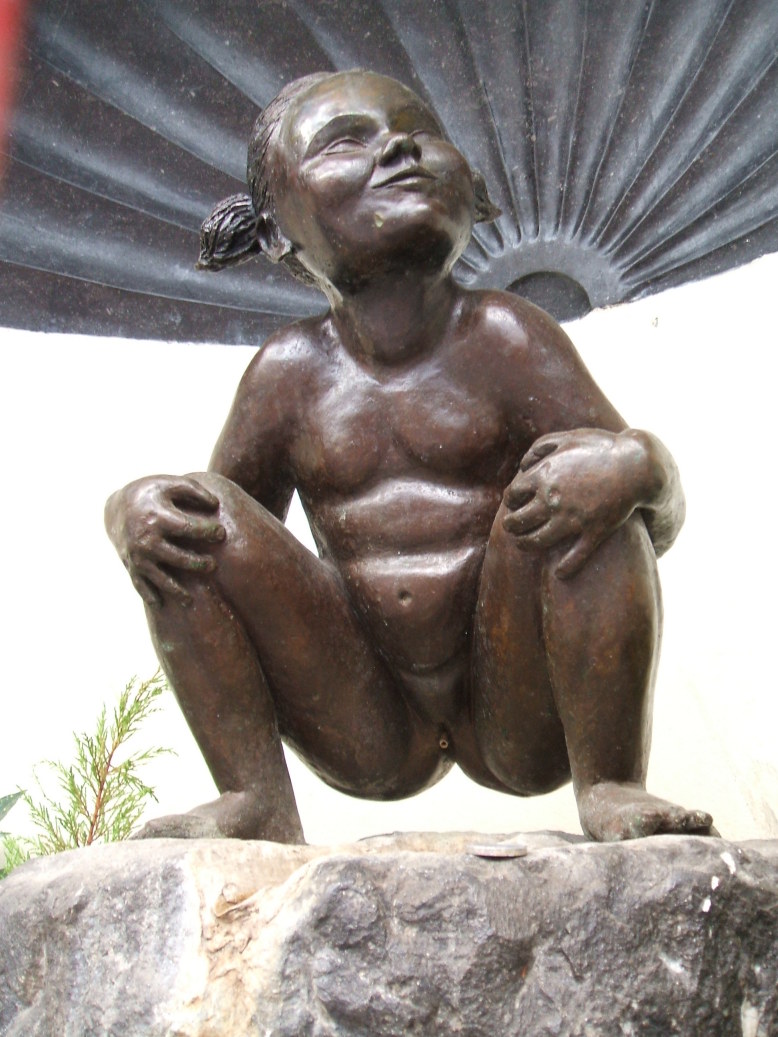
The easiest way to get there might be to follow directions to the Delirium Tremens cafe, directly across the narrow alley. They have over 2,000 beers on their menu, and are a very popular tourist site. Across the alley, next to Jeanneke, they have an absinthe bar with a few hundred choices.
The creator of Jeanneke Pis seems to be a practitioner of absurdism. The sign by the fountain says, spelling, grammar, and all:
A very old custom has it that your wish be granted if you throw a coin into the bowl of the fountain. The coins thrown by passers-by into the fountain of Jeanneke Pis bears witness to Tenderness, Virtue ans Admiration of the loved one with the wish to remain faithful to one another.
Yes, it really says "ans"...
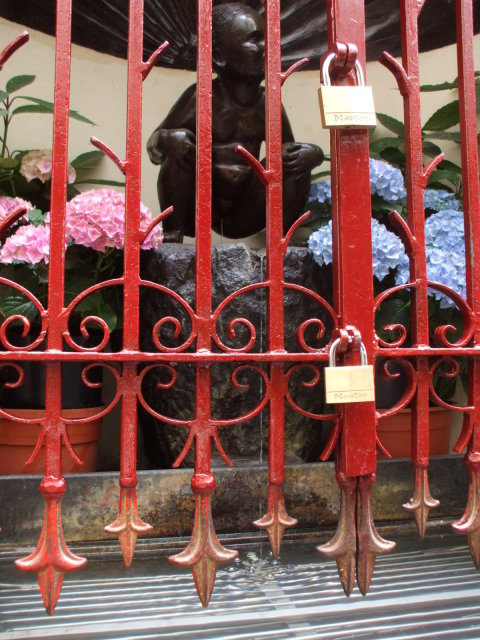
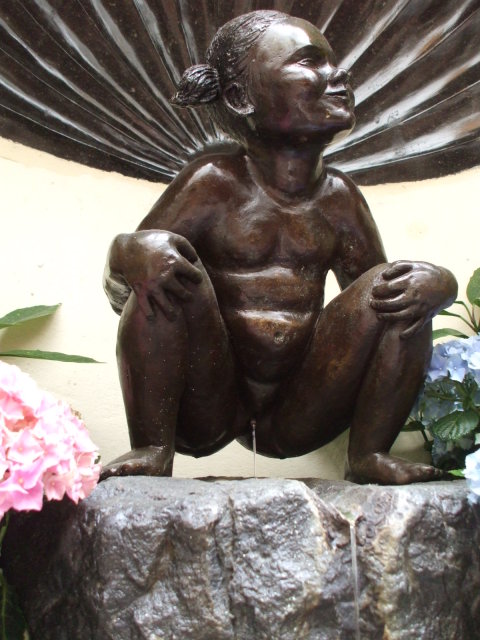
Zennike Pis, The Peeing Dog
Well, if two statues are a good thing, then adding a third statue of a peeing dog would be THREE TIMES as good!
And so Zennike Pis was created.
Like both Manneken Pis and Jeanneke Pis, Zennike Pis is plumbed for realistic operation. But alas, he has not been operating when I have visited...
To get there, he's at the corner of Rue Van Artevelde / Arteveldestraat and Rue St-Kristoffel / St-Kristoffel Straat. Start at the Bourse along the main north-south Boulevard Anspach / Anspachlaan. Three streets fan out from the opposite site of the boulevard — take the left-most one, Rue J. Van Praet / J. Van Praet Straat. The Mappa Mundo bar is across the triangular square at the far end of the block. All the Thai and Vietnamese restaurants along that block and the bars around the square are great places, by the way. Anyway, Zennike Pis is around the triangular block on which Mappa Mundo is found.
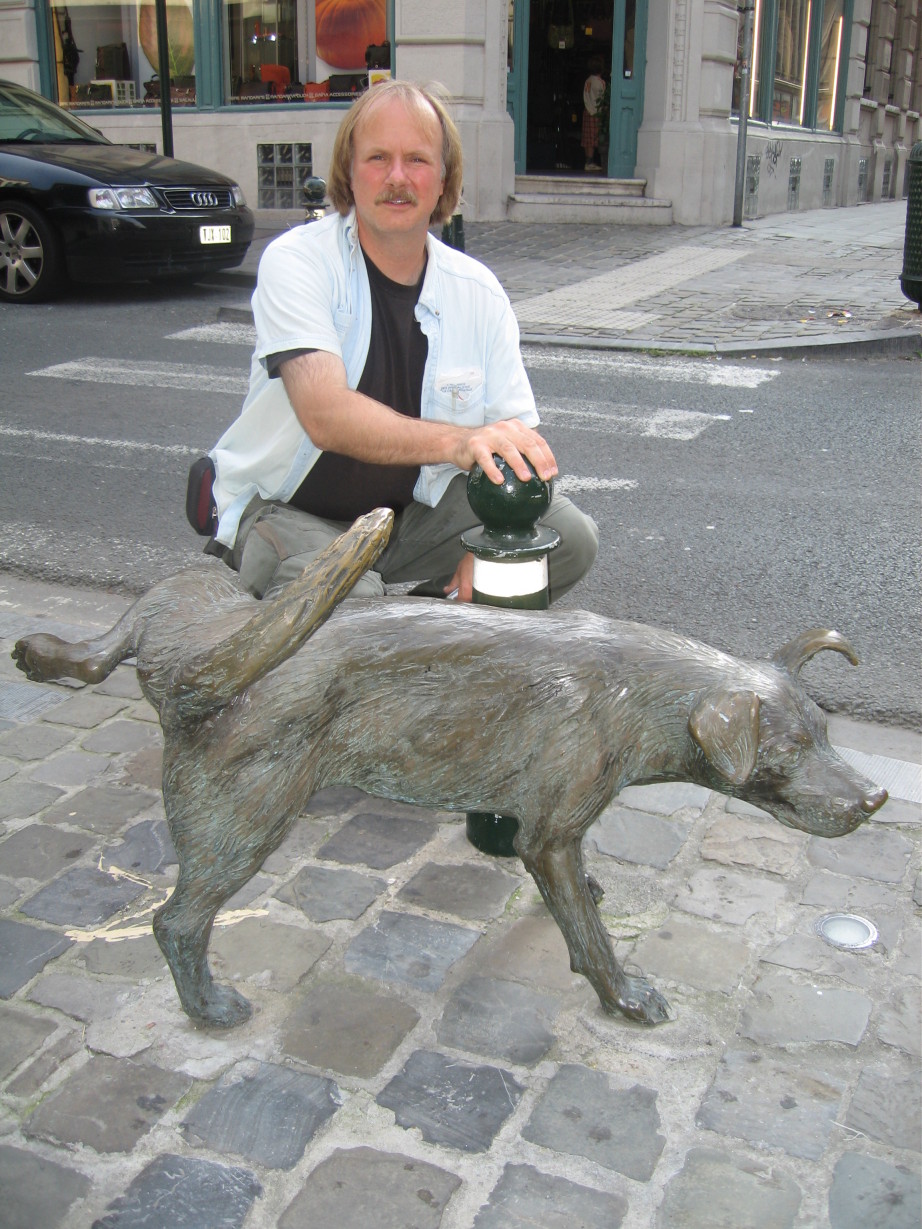
Zennike was created by Belgian artist Tom Frantzen.
"Zennike" is based on a Flemish word for "mongrel". As the artist says, "Because he is a dog of mixed breed, he symbolises the multicultural nature of Brussels."
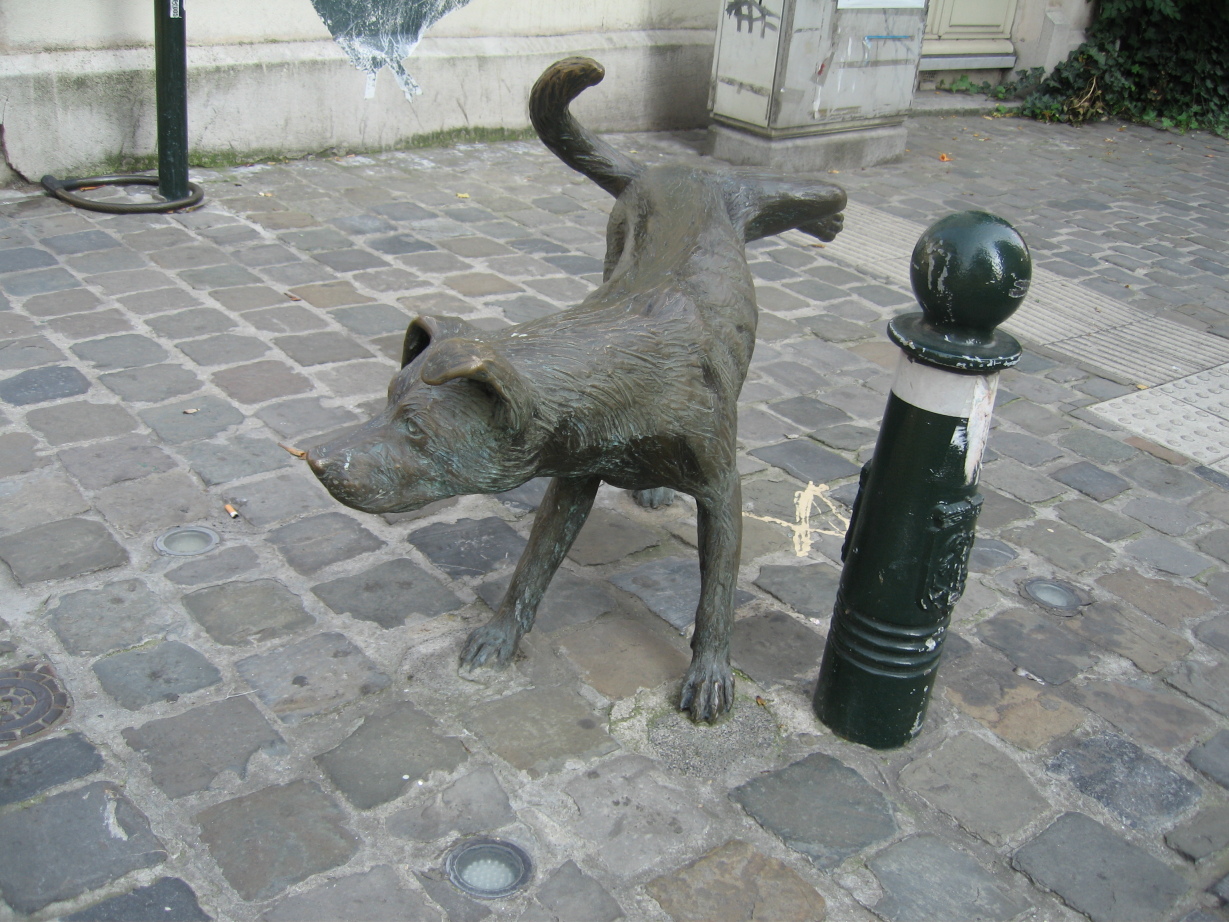
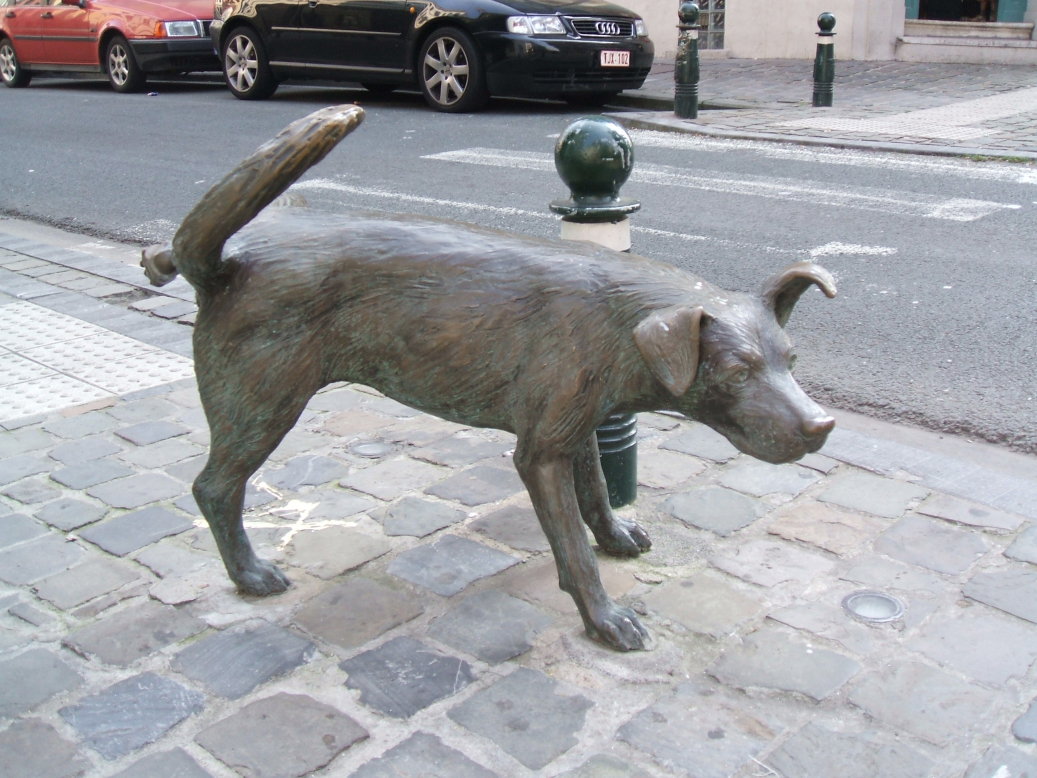
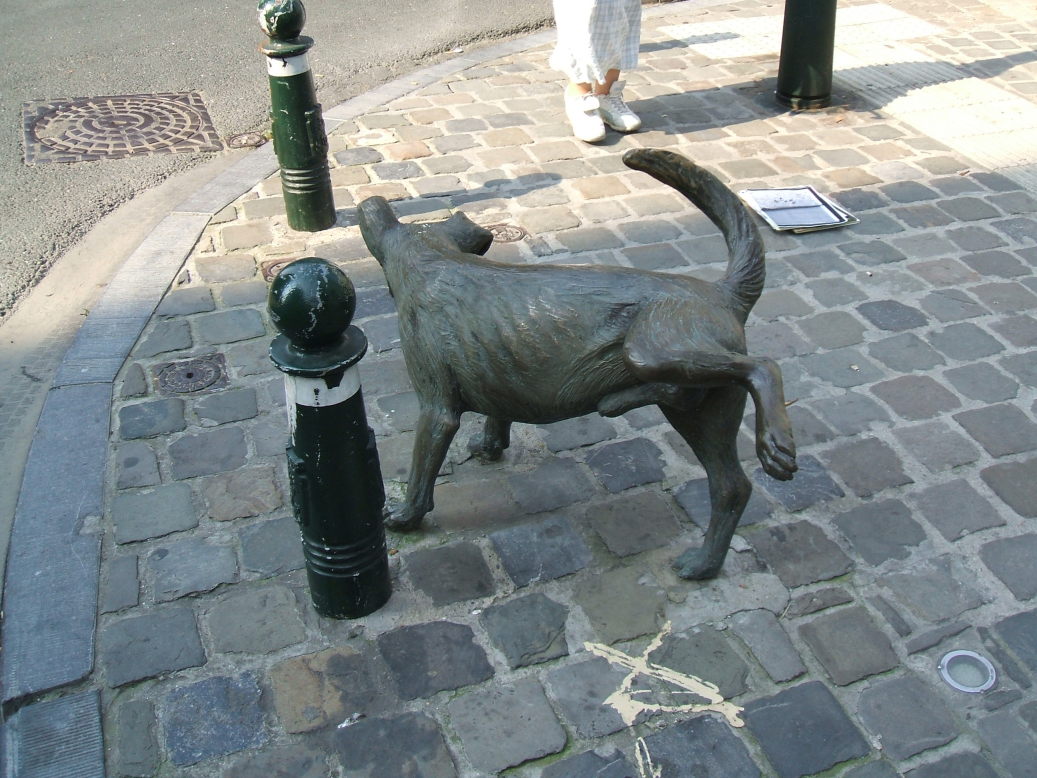
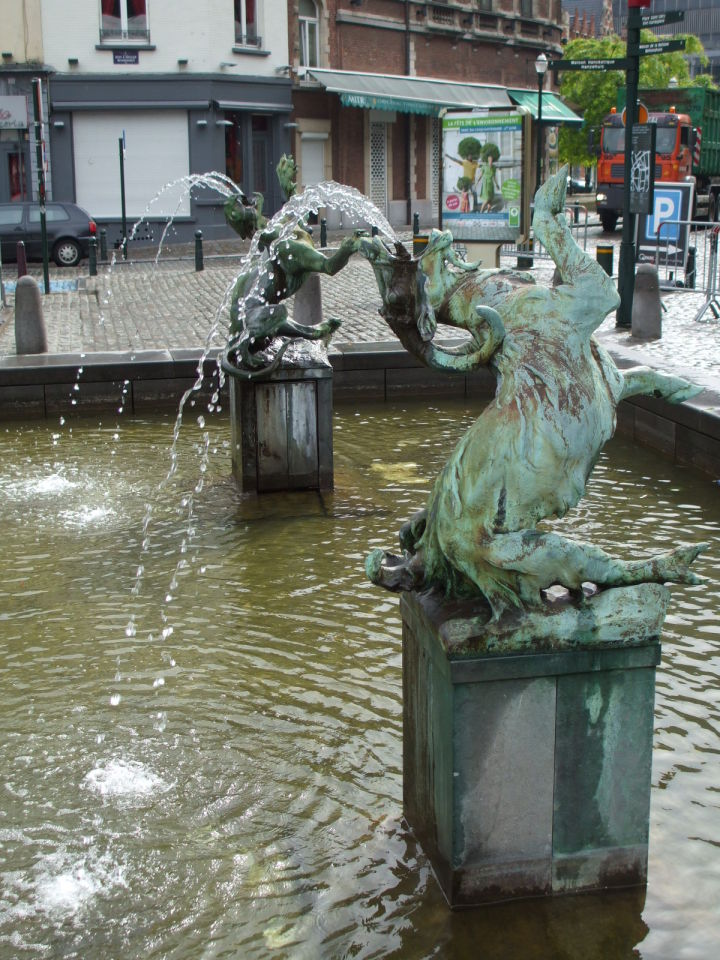
Finally, Brussels has paired statues of what appear to be vomiting goats. I don't know if they are intended as part of the theme, it's hard to tell...
These are at the south end of the park on the north side of St Catherine's Cathedral.